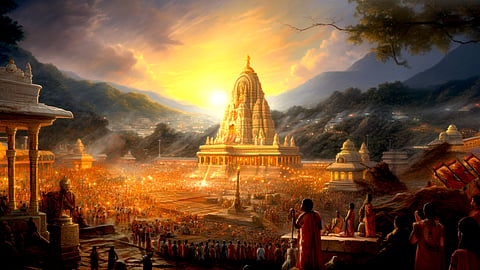- Commentary
- History Vignettes
- Notes on Culture
- Dispatches
- Podcasts
- Indian LanguagesIndian Languages
- Support

IN THE FINAL LEG of his sojourn in Tirumala in 1872, V.N. Narasimha Iyengar recounts rare anecdotes about the glory of Srinivasa. His eyewitness descriptions of the condition of the temple, its surroundings and the various traditions and practices associated therewith are eye-opening to say the least.
Read on!
TIRUMALA SRINIVASA IS THE GOD which attracts so many devotees from all parts of India. It is believed to be dire destruction to offend Him. He can only be propitiated by rich donations. He inspires the scoffer with dread. He is believed to survive all the great deluges which will one day overtake the world.
The wealth of the temple is considered fabulous. The managers are the Bhairagees who have got unchecked sway over the vast wealth of the institution. The chief guru of the Bhairagees is called the Mahant of the Math of Hathi Ram. The temple receives donations from men in all parts of India. The collections are estimated at four lakhs...
One of the sources of the temple revenues is the sale of the prepared rice. Numerous grandees have instituted charities in this temple, by which the founders intended that the food after being shown to the god should be distributed to travellers and poor people. But what we see now is a direct violation of the intentions of the founders. In the first place, the food is not properly prepared.. Our Mysore Raja has founded a charity by which one gangala (large vessel) full of rich food should be daily offered to the God and distributed to the poor and strangers. There is a chatram of the Mysore Maharaja on the hill...
The Kalyana Mantapams are used when the ceremony of the God’s marriage is gone through every year. They are really very good pieces of sculpture.
The Garbha-griham is darkened by the fumes of camphor which is incessantly burned at the request of devotees. One Mangalarati costs one rupee.
At the foot of the Tirumala hills, there is a big spire. Part of it was, it appears, struck down by lightning. Numerous big pairs of shoes and wooden sandals are kept here and the legend is that they are used by the great God Srinivasa.
On the top of the hill, no one is allowed to wear flowers in his locks in honour of the God.
The tradition is that some ruffianly Pujari had been formerly keeping a mistress to whom he conveyed the flower intended for the God. One of the Anegondi Rajas, who was at the period the ruler of this region, enquired about the matter. The Pujari secretly transferred the flowers to the God from the head of his mistress. The Raja received it, but noticed a hair in it which the Pujari affirmed belonged to the God. In order to save his worshipper’s neck, Srinivasa Svami confirmed the falsehood, but ordered that nobody should wear flowers hereafter while on the top of the hill.
Within the second prakara or circle, there is a small cistern into which the washings of the God flow through a secret channel... There is a profuse waste of the scents in this water. But in other respects, it is very filthy and unfit even for our touch. Every pilgrim is required to swallow a handful of this water on pain of the direst consequences. Diwan Purnaiya, it appears, loathed to do this, and instantly lost, his eye-sight. Someone advised him to do penance. Part of it consisted of washing his eyes with the Thotti Teertham, as this cistern water is called. His faith was rewarded by the restoration of his eyes.
The descent is weary and distressful walking. Telugu is spoken throughout the country. The ethnology, manners and customs of this region differ from those of the Madras side.
17th December 1872
FROM TIRUPATI, THE RAILROAD goes through a hilly and wild country and the survey was very striking, especially as we looked at it in the moonlight.
The knowledge that there is a police station on the top of the hill and that any injury to our person and property will not go unpunished were very reassuring to us.
The Bhairagi Math people have watchmen at intervals along the ascent. They are armed with antediluvian matchlocks, such as are found with the Hale Paika men of the Malnad
The late Mr. Singriengar of Bangalore is a well-known character here. He has founded several charities and sevas or services and his chattram at Aitepalli, twelve miles from Tirupati, is well known to most travellers. It was the ark of safety and comfort before the days of the railway.
We did part of the descent walking on foot. It was very weary, and I felt the pain in my thighs and calves for days after. The descent from the Gali Gopuram is very distressing and fearful. It was about 6 p.m. by the time we returned to the town of Tirupati, utterly exhausted and weary.
The town of Tirupati and the settlement on the top of the hills are full of monkeys. They thrive in the same manner as the Brahmans who are equally filthy.
In pursuance of our programme, we started after tea, for Tiruchanur, about two miles from Tirupati. We were very kindly assisted by Shama Rao, a local pleader and a very intelligent man.
There is a temple at Tiruchanur dedicated to Lakshmi and it is in charge of the Mahant. It was under repair. The style of architecture is the same as at Tirupati. There is a very nice pond near the temple, which contains clear water, although people wash themselves freely in it. The vegetable matter in the pond absorbs all organic impurities and hence the clear water.
Concluded
The Dharma Dispatch is now available on Telegram! For original and insightful narratives on Indian Culture and History, subscribe to us on Telegram.
